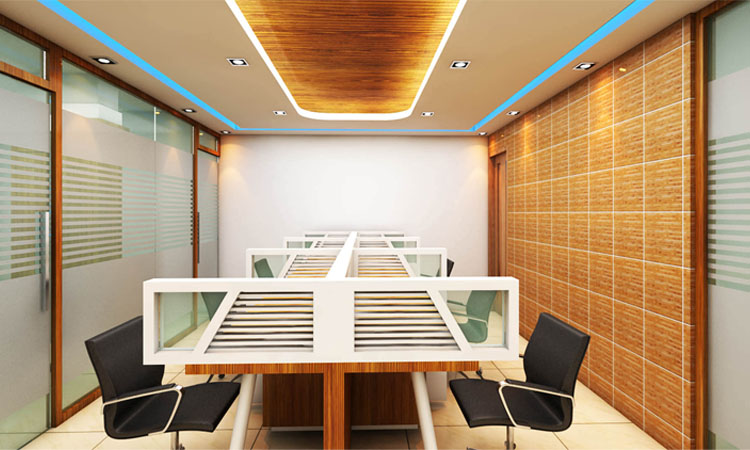Office design significantly impacts employee well-being and productivity. By understanding the psychology behind workspace design, businesses can create environments that foster positive moods, enhance performance, and promote overall job satisfaction. This article delves into the key psychological principles of office interior design and offers strategies for creating a workplace that supports employee well-being and productivity.
The Psychological Principles of Office Design
1. Biophilic Design
Biophilic design involves incorporating elements of nature into the office environment. This approach has been shown to reduce stress, improve mood, and enhance cognitive function. Key biophilic design elements include:
- Natural Light: Maximizing natural light helps regulate circadian rhythms, which can improve sleep, mood, and productivity.
- Plants and Greenery: Introducing indoor plants and greenery can improve air quality, reduce stress, and create a calming atmosphere.
- Natural Materials: Using materials such as wood, stone, and natural fibers can evoke a sense of nature and enhance the aesthetic appeal of the office.
2. Color Psychology
Colors have a profound impact on emotions and behavior. Understanding color psychology can help create an office environment that promotes specific moods and productivity levels:
- Blue: Blue is calming and helps improve focus and productivity, making it ideal for work areas.
- Green: Green is associated with tranquility and balance. It reduces stress and promotes a sense of well-being.
- Yellow: Yellow is stimulating and can boost creativity and energy, making it suitable for creative spaces.
- Red: Red is energizing and can increase alertness, but it should be used sparingly as it can also induce stress.
3. Ergonomics
Ergonomic design focuses on creating a comfortable and efficient workspace that minimizes physical strain and injury. Key ergonomic considerations include:
- Adjustable Furniture: Desks and chairs that can be adjusted for height and posture support reduce discomfort and promote proper alignment.
- Keyboard and Mouse Placement: Ensuring that keyboards and mice are positioned to allow for natural wrist and arm movements can prevent strain.
- Monitor Height: Positioning monitors at eye level helps reduce neck and eye strain.
4. Personalization
Allowing employees to personalize their workspaces can enhance their sense of ownership and satisfaction. Personalization can include:
- Decor and Accessories: Let employees decorate their desks with personal items, such as photos, artwork, or plants.
- Flexible Layouts: Provide options for different workspace configurations to accommodate individual preferences and work styles.
5. Noise Management
Excessive noise can be a major distraction and source of stress in the workplace. Effective noise management strategies include:
- Acoustic Panels: Installing acoustic panels on walls and ceilings can absorb sound and reduce noise levels.
- Quiet Zones: Designate specific areas for quiet work, where employees can focus without interruptions.
- White Noise Machines: Using white noise machines can help mask background noise and create a more conducive environment for concentration.
6. Social Spaces
Social interactions are crucial for employee well-being and collaboration. Designing spaces that facilitate social interactions can enhance teamwork and job satisfaction:
- Break Rooms: Create inviting break rooms where employees can relax, socialize, and recharge.
- Collaboration Zones: Designate areas for group work and brainstorming sessions to encourage collaboration and innovation.
- Common Areas: Include common areas with comfortable seating where employees can have informal conversations and build relationships.
Strategies for Creating a Psychologically Optimized Office

1. Flexible Workspaces
Flexible workspaces cater to different work styles and activities. Incorporate a variety of work areas, such as:
- Hot Desks: Provide unassigned desks that employees can use as needed, promoting flexibility and mobility.
- Private Pods: Include small, enclosed pods for focused work or private conversations.
- Collaborative Spaces: Design areas for group activities and meetings with flexible seating arrangements.
2. Wellness Rooms
Wellness rooms offer a space for employees to relax, meditate, or take a break from work. These rooms can be equipped with comfortable seating, soothing decor, and resources for relaxation, such as books or meditation guides.
3. Technology Integration
Integrating technology into the office design can enhance productivity and comfort:
- Smart Lighting: Use smart lighting systems that adjust brightness and color temperature based on the time of day and natural light levels.
- Temperature Control: Implement smart thermostats to maintain a comfortable temperature and improve energy efficiency.
- Collaboration Tools: Equip meeting rooms with the latest collaboration tools, such as video conferencing systems and interactive whiteboards.
4. Inclusive Design
Inclusive design ensures that the office environment is accessible and accommodating for all employees. Consider the following:
- Universal Design Principles: Apply universal design principles to create spaces that are usable by people of all abilities.
- Accessible Workstations: Ensure that workstations are adjustable and accessible to employees with disabilities.
- Diverse Spaces: Include spaces that cater to diverse needs, such as prayer rooms, lactation rooms, and gender-neutral restrooms.
5. Break and Activity Areas
Incorporating areas for breaks and physical activity can boost employee well-being and productivity:
- Fitness Facilities: Provide on-site fitness facilities or access to nearby gyms to encourage physical activity.
- Outdoor Spaces: Create outdoor areas where employees can take breaks, enjoy nature, and get fresh air.
- Recreation Areas: Include spaces for recreational activities, such as game rooms or relaxation lounges.
Conclusion
Understanding the psychology of office design is crucial for creating workspaces that enhance employee well-being and productivity. By incorporating biophilic design, considering color psychology, prioritizing ergonomics, allowing personalization, managing noise, and creating social spaces, businesses can design offices that support positive moods and high performance. Investing in psychologically optimized office design not only benefits employees but also contributes to overall organizational success.

